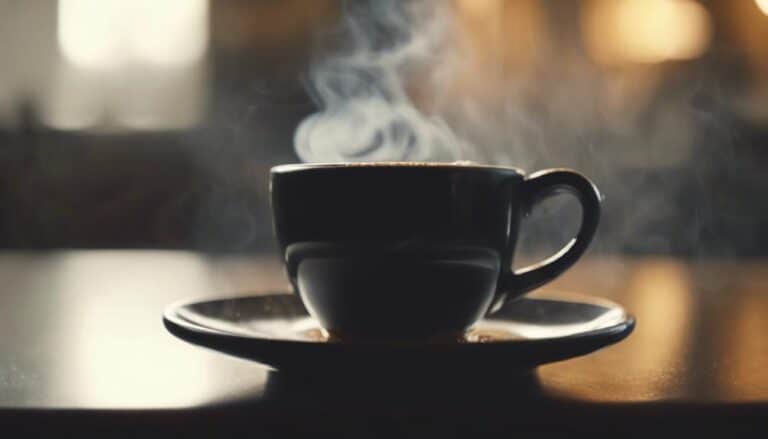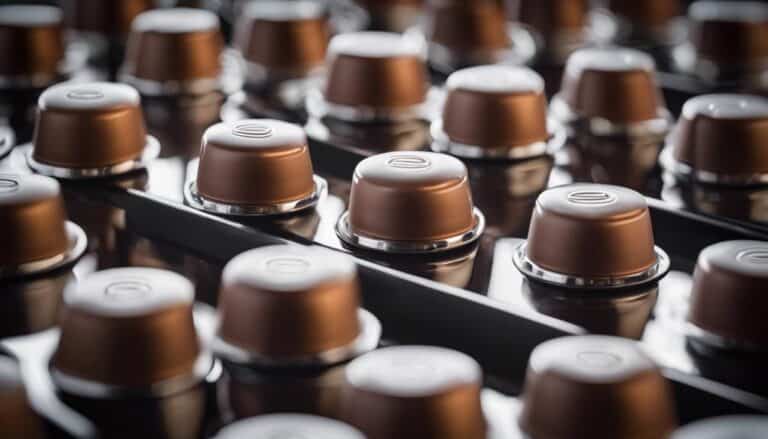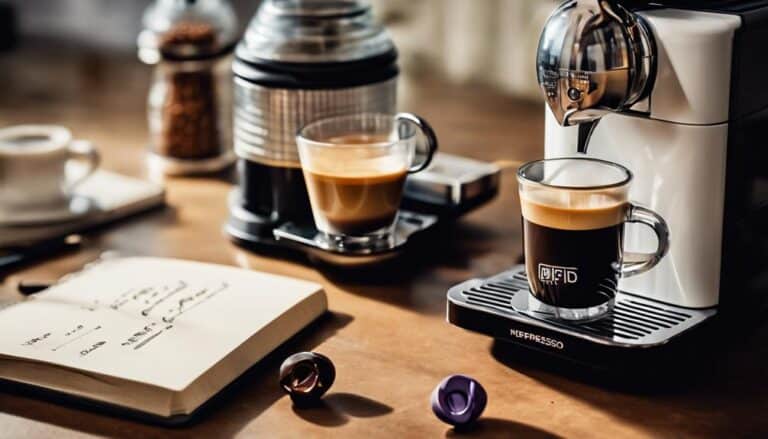Why You Must Try Starbucks Matcha Tea Powder
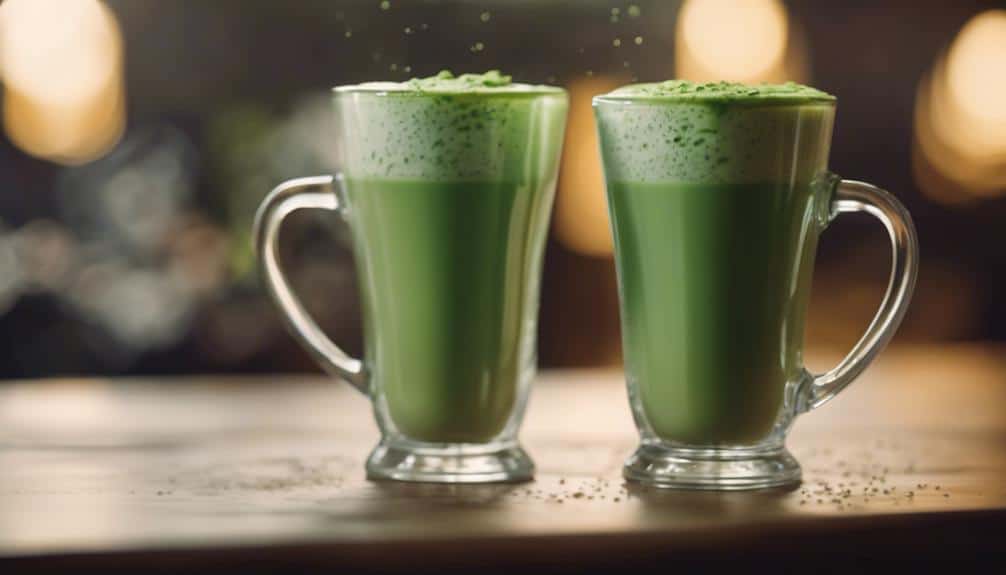
As someone who appreciates the finer things in life, I recently stumbled upon a game-changer in the world of matcha. Starbucks Matcha Tea Powder has truly captivated my taste buds with its unparalleled blend of sweetness and earthiness. The journey from that first sip to the last is nothing short of exquisite, making each moment with this matcha powder a true treat for the senses. But what sets this matcha apart from the rest? There's a secret ingredient that elevates the experience to a whole new level, one that you won't want to miss out on.
Benefits of Starbucks Matcha Powder
Starbucks Matcha powder guarantees a delightful blend of sweetness and quality, making it a popular choice among tea enthusiasts looking for a flavorful and convenient option. The pre-sweetened nature of Starbucks Matcha powder guarantees that every cup delivers a consistent level of indulgent sweetness without the need for additional sugar. The green color of the Matcha powder is vibrant and inviting, hinting at the rich flavor that awaits.
The added sugar content, while high at 51%, contributes to the luxurious and satisfying taste that Starbucks Matcha is known for. Despite being economy-grade, the quality of the Matcha used in Starbucks' blend strikes a balance between taste and affordability. This blend is carefully crafted to provide a harmonious experience for those seeking a quick and delicious Matcha fix. With Starbucks Matcha powder, you can enjoy the convenience of a pre-sweetened option without compromising on flavor or quality.
Unique Flavor Profile of Starbucks Matcha
With a symphony of flavors dancing on the palate, the distinctive character of Starbucks Matcha reveals a delightful fusion of sweetness and vegetal undertones. Unlike traditional Matcha, Starbucks Matcha powder is pre-sweetened, impacting its flavor profile significantly.
The blend of sweetness from added sugar with a slightly bitter vegetal note creates a taste that's unique to Starbucks Matcha. This pre-sweetened nature makes Starbucks Matcha less sweet compared to other green tea drinks made with pure Matcha powder.
The sugar content not only affects the taste but also influences the powder's solubility, as it may not dissolve easily in water due to the added sugar. When recreating Starbucks matcha beverages at home, taking into account the distinct flavor profile of the Matcha powder Starbucks uses is crucial, ensuring a balance of sweetness and vegetal flavors in your Matcha latte or other green tea-based drinks.
Experimenting with Matcha powder scoops can help you achieve the desired taste similar to what Starbucks offers.
Versatility in Recipes With Starbucks Matcha
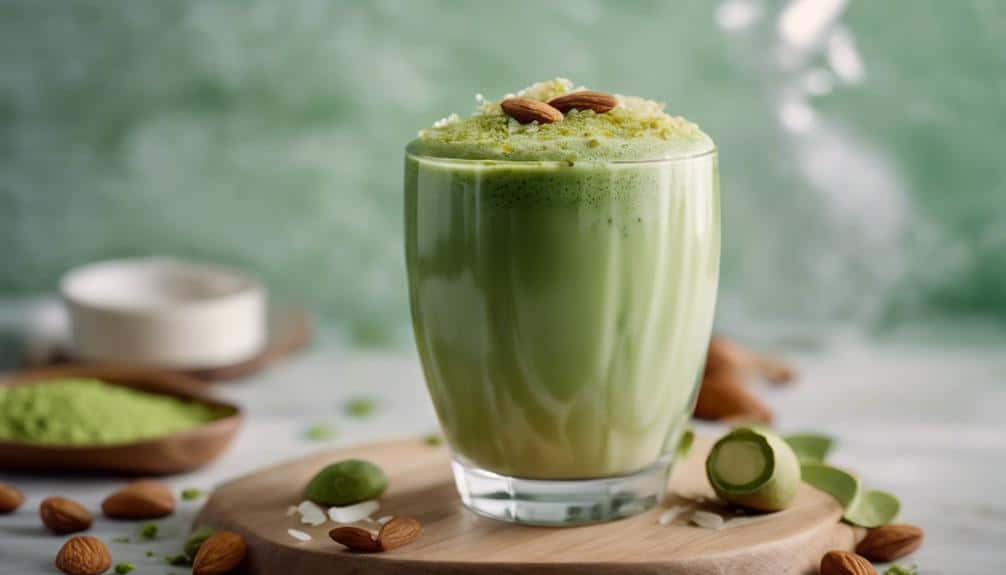
Indulging in the culinary world's palette with Starbucks Matcha tea powder opens up a domain of creative possibilities for both drinks and desserts.
The vibrant green color and delicate sweetness of Starbucks Matcha make it a versatile ingredient that can transform ordinary recipes into extraordinary culinary creations. From classic lattes to indulgent frappuccinos, Starbucks Matcha adds a unique twist to your favorite beverages.
But the versatility of this ingredient doesn't stop there; you can enhance your desserts by incorporating Matcha into cakes, cookies, or even creamy ice creams.
Additionally, Starbucks Matcha can surprise your taste buds in savory dishes like stir-fries or marinades, offering a new dimension to your cooking repertoire.
Convenience of Using Starbucks Matcha
Enhancing your daily routine with the convenience of pre-sweetened Matcha powder elevates your beverage experience to a new level of simplicity and flavor. Starbucks Matcha powder's pre-sweetened formulation guarantees a consistent sweetness in every sip, saving you the hassle of measuring and adding sugar. This ready-to-use solution provides a quick and effortless way to enjoy a delicious Matcha drink without compromising on taste.
| Benefits of Starbucks Matcha Powder | |
|---|---|
| Convenient | Perfect for quick preparation |
| Consistent Sweetness | Guarantees every drink has the right amount of sweetness |
| Eliminates Need for Sugar | No extra sweeteners required |
| Familiar Taste | Enjoy a consistent taste experience |
Whether you're at home, work, or on the go, the convenience of Starbucks Matcha powder allows you to indulge in a high-quality Matcha beverage without any extra effort. Experience the ease and deliciousness of Starbucks Matcha in every cup!
Quality Standards of Starbucks Matcha

When evaluating the quality standards of Starbucks Matcha, one must consider aspects like the sourcing of the Matcha, the processing of the powder, as well as the resulting flavor and aroma.
Understanding these critical points will shed light on the overall quality and taste of the Matcha you're consuming.
Starbucks Matcha Sourcing
Starbucks carefully sources shade-grown milled green tea from Korea, Japan, and China to create their Matcha powder, guaranteeing a blend that meets their quality standards. The quality of Matcha used in Starbucks' blend is considered economy-grade, with a possibility that it may be sencha rather than traditional Matcha.
In the U.S., Starbucks' Matcha powder contains more sugar than tea, unlike the unsweetened blend in Canada. Starbucks Matcha scoops come pre-sweetened with a blend where sugar is the primary ingredient.
This sourcing process guarantees that Starbucks maintains a distinct flavor profile in their Matcha powder, offering a unique and consistent experience to customers seeking a delightful beverage option.
Matcha Powder Processing
In crafting Starbucks Matcha powder, a meticulous process guarantees the quality standards are upheld to deliver a delightful and consistent beverage experience. Starbucks sources shade-grown milled green tea from Korea, Japan, and China for their matcha powder, ensuring a diverse and unique flavor profile.
While the matcha used is economy-grade and not 100% pure Japanese Matcha, the careful selection process still maintains a certain level of quality. The pre-sweetened nature of Starbucks matcha powder, with at least 51% added sugar, adds a touch of sweetness to the blend.
This processing method might result in a slightly different taste experience compared to traditional matcha, but it offers a convenient and accessible option for matcha enthusiasts looking to enjoy a quick and satisfying drink.
Flavor and Aroma
Indulging in a sip of Starbucks Matcha powder reveals a symphony of flavors and aromas that embody the brand's distinct quality standards.
While Starbucks Matcha tea blend offers convenience, the added sugar content, at least 51%, can noticeably alter the flavor profile, sometimes overshadowing the delicate notes of traditional Japanese Matcha.
The economy-grade quality of the Matcha used in Starbucks may impact the overall aroma, as premium variations grown in specific regions provide a more refined taste experience.
It's crucial to note that the sugar content in Starbucks Matcha might compromise the potential health benefits typically associated with Matcha consumption.
Despite these considerations, Starbucks Matcha still presents an accessible option for those seeking a quick and familiar Matcha fix.
Comparing Starbucks Matcha to Others
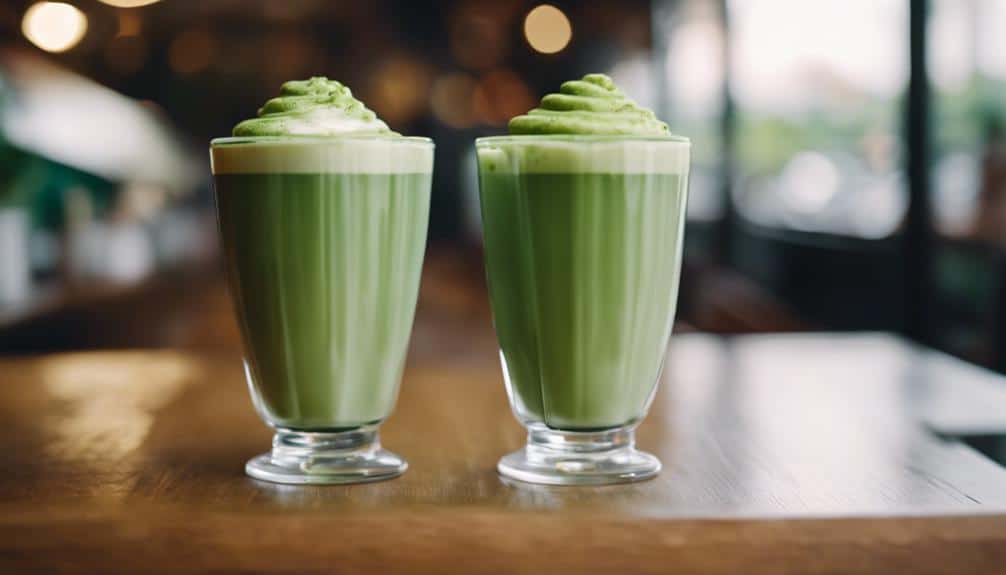
When evaluating Starbucks Matcha compared to other brands, the taste difference is quite noticeable; Starbucks Matcha tends to be sweeter due to the added sugar content.
Reviewing the quality of Matcha used in Starbucks reveals that it's economy-grade, impacting both the flavor and authenticity of the drink.
This comparison highlights the importance of understanding the nuances in Matcha quality and taste when selecting your preferred brand.
Taste Comparison
Comparing Starbucks Matcha to others, one immediately notices the distinct sweetness and economy-grade flavor profile that sets it apart from authentic Japanese Matcha varieties. The added sugar content in Starbucks Matcha powder, at least 51%, greatly impacts its taste profile, making it sweeter compared to traditional Matcha.
The economy-grade quality of Matcha used by Starbucks also plays a role in the overall flavor, resulting in a less vibrant and fresh taste experience. Starbucks Matcha beverages being pre-sweetened further contribute to their unique flavor, different from the traditional Matcha taste.
When recreating Starbucks Matcha drinks at home, one might encounter a less sweet taste due to the absence of pre-sweetened powder, allowing for a more customizable flavor profile.
Quality Assessment
When evaluating the quality of Starbucks Matcha in comparison to other varieties, one can discern notable differences in flavor and ingredient composition that impact the overall tea experience. Here are four key points to ponder:
- Starbucks Matcha contains at least 51% added sugar, affecting its authenticity compared to 100% pure Japanese Matcha.
- The utilization of economy-grade Matcha in Starbucks blend influences the flavor profile, potentially diminishing the tea's quality.
- Starbucks Matcha powder isn't sourced as authentic Matcha from regions like Uji and Kyoto, leading to lower antioxidants and a less superior taste.
- Counterfeit Matcha, often found in non-authentic products, has a distinctly different flavor profile compared to genuine Japanese Matcha, further emphasizing the importance of choosing authentic sources.
Starbucks Matcha Vs. Traditional Matcha
Regularly, I savor the vibrant, pure taste of traditional Matcha, relishing its unsweetened simplicity and healthful properties. Traditional Matcha is pure Green tea powder, unlike Starbucks Matcha, which contains at least 51% added sugar. The 16oz Starbucks Matcha latte, with 32g of sugar, contrasts starkly with the unsweetened nature of traditional Matcha. The added sugar in Starbucks Matcha might guarantee the full health benefits typically associated with pure Matcha.
While traditional Matcha is ground Japanese Green tea, Starbucks Matcha is a blend that includes economy-grade Matcha powder, affecting both its quality and flavor. The use of ceremonial-grade Matcha in traditional Matcha ensures a superior taste and more health benefits compared to Starbucks Matcha.
When it comes to choosing between Starbucks Matcha and traditional Matcha, the decision boils down to whether one prefers added sweetness and an economical option or values the purity and health benefits of ceremonial-grade Matcha.
Sustainable Sourcing of Starbucks Matcha

As we explore the origins of Starbucks Matcha, the blend's journey from Korea, Japan, and China reveals the intricate tapestry of sustainable sourcing practices that underpin its creation.
Starbucks sources its matcha from diverse regions, ensuring a blend that captures the essence of each origin while supporting various communities.
The quality and environmental impact of Starbucks matcha are deeply intertwined with the ethical sourcing of matcha, emphasizing fair treatment of workers and sustainable farming practices.
Understanding the origin of Starbucks matcha powder isn't just about tracing its roots but also about appreciating the authenticity of the product and the efforts behind its sourcing.
Embracing sustainable sourcing practices not only enhances the consumer experience but also contributes to the preservation of matcha cultivation for future generations, highlighting the significant impact of Starbucks matcha sources on the industry.
Conclusion
To sum up, Starbucks Matcha Tea Powder is a must-try for anyone looking to enhance their matcha experience. With its pre-sweetened nature, vibrant green color, and unique flavor profile, this high-quality powder offers convenience, versatility, and consistent taste in every sip.
Whether you're a matcha enthusiast or new to the world of matcha, Starbucks Matcha promises a delightful and indulgent experience that's sure to impress. Don't miss out on this exceptional matcha powder from Starbucks!
